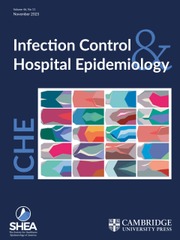In this letter, we would like to share an idea and a tool regarding antimicrobial stewardship and drug costs that can be useful for hospital antimicrobial stewardship teams.
The emergence of antimicrobial-resistant bacteria represents a major global public health challenge. 1,2 Antimicrobial stewardship aims to promote the judicious use of antimicrobials to optimize therapeutic outcomes while mitigating the emergence and dissemination of antimicrobial resistance (AMR). Reference Zay Ya, Win, Bielicki, Lambiris and Fink3 In clinical practice, the administration of broad-spectrum antimicrobials may occasionally be necessary; however, their overuse should be minimized, as it accelerates the development of AMR. Thus, it is preferable to select narrow-spectrum antimicrobials when clinically appropriate. Nonetheless, clinicians often face difficulties in accurately assessing the spectrum of antimicrobial activity and treating patients properly.
Recently, several objective metrics for quantifying the antimicrobial spectrum have been developed, including Antibiotic Spectrum Coverage (ASC) score. Reference Ilges, Tande and Stevens4 ASC score, which defines the activity of 77 antimicrobials against 16 clinically significant bacteria, is currently the most comprehensive spectrum score available. Reference Kakiuchi, Livorsi and Perencevich5 Ranging from 1 to 14, a higher score signifies broader antimicrobial activity, facilitating comparisons of the spectrum breadth across different antimicrobials.
When determining an antimicrobial treatment strategy, we think that consideration of drug costs is equally important from an economic perspective, alongside the antimicrobial spectrum. Given the finite nature of healthcare financial resources, healthcare professionals must provide effective treatment while minimizing expenses. Data from the Organization for Economic Co-operation and Development from 2011 to 2021 shows that pharmaceutical expenditures are increasing in most member countries, thereby contributing to the financial burden on healthcare systems. 6 Additionally, high drug costs can pose an economic burden not only on national insurance systems but also on individual patients. Therefore, selecting less expensive drugs is preferable when clinical efficacy is comparable. However, clinicians often struggle to accurately estimate drug costs, highlighting the need for accessible cost information. Reference Allan, Lexchin and Wiebe7
To address these issues, we developed the “Two-Dimensional Chart for Antimicrobial Spectrums and Costs” (Figure 1), which visualizes ASC scores and antimicrobial costs. The vertical axis represents daily drug costs, while the horizontal axis shows ASC scores, plotting intravenous antibiotics that have an ASC score and are available in our hospitals. Antimicrobials are color-coded according to the AWaRe classification proposed by the World Health Organization, grouping them into “Access,” “Watch,” and “Reserve” categories. 8 To visualize antimicrobials recommended for routine use based on AMR strategy and cost, we intentionally applied a color scheme in the lower-left area of the graph, shown as the blue zone. Consequently, most of the Access antibiotics, including benzylpenicillin, ampicillin(/sulbactam), cefazolin, clindamycin, and metronidazole, are placed inside the blue zone. Also, some of the Watch antibiotics, such as ceftriaxone, ceftazidime, azithromycin, and vancomycin, are positioned within the zone. While none of the Reserve antibiotics are included.

Figure 1. Two-dimensional chart for antimicrobial spectrums and drug costs. The vertical axis represents daily drug costs in Japan on logarithmic scale (as of March 2025), while the horizontal axis shows the Antibiotic Spectrum Coverage (ASC) scores of each intravenous antibiotic. Green, yellow, and red dots indicate the Access, Watch, and Reserve groups in the AWaRe classification, respectively. (Note: Minocycline and fosfomycin are categorized as the Watch group when administered orally, while they are classified as the Reserve group when administered intravenously.) ABPC, ampicillin; ABPC/SBT, ampicillin/sulbactam; AMK, amikacin; AZM, azithromycin; CAZ, ceftazidime; CEZ, cefazolin; CFPM, cefepime; CLDM, clindamycin; CPFX, ciprofloxacin; CTLZ/TAZ, ceftolozane/tazobactam; CTRX, ceftriaxone; CTX, cefotaxime; DAP, daptomycin; DRPM, doripenem; FOM, fosfomycin; GM, gentamicin; IPM/CS, imipenem/cilastatin; LVFX, levofloxacin; LZD, linezolid; MEPM, meropenem; MINO, minocycline; MNZ, metronidazole; PCG, benzylpenicillin; PIPC, piperacillin; PIPC/TAZ, piperacillin/tazobactam; ST, sulfamethoxazole/trimethoprim; TOB, tobramycin; TZD, tedizolid; VCM, vancomycin.
The line-up of antibiotics within the blue zone aligns with our routine recommendations, and we employ this chart in our antimicrobial stewardship activities to efficiently suggest antimicrobial treatment that incorporates economic considerations as well. This chart can be easily customized to reflect antimicrobials available at each medical situation and the regional variations in drug costs, thus supporting appropriate antimicrobial selection from both AMR and economic perspectives.
There are several limitations to this chart regarding its generalizability. Firstly, not all antimicrobials are defined by the ASC score. For example, cefmetazole, commonly used in Japan, is unavailable in the United States and lacks an ASC score. To address this, it may be required to independently estimate scores based on the ASC methodology or consider alternative scoring systems. Secondly, the ASC score simply represents the absolute broadness of the antimicrobial spectrum, and thus, this chart does not provide information on the specific bacteria against which an antimicrobial agent is effective. Therefore, when clinically applied, it is necessary to consider the range of bacteria covered by each antimicrobial. Thirdly, drug costs can vary depending on antibiotic dosages and may be reduced in cases involving renal dysfunction, as well as pediatric and/or geriatric patients.
In your institution, what do you think about the drug costs when promoting antimicrobial stewardship? In our opinion, saving drug costs is as crucial as AMR countermeasures for providing sustainable healthcare services. Visualizing ASC scores and drug costs with this two-dimensional chart potentially supports appropriate drug selection from both AMR and economic perspectives and could play a valuable role in antimicrobial stewardship activities across various facilities.
Data availability statement
The datasets used in this study are available from the corresponding author upon request.
Financial support
None reported.
Competing interests
All authors report no conflicts of interest relevant to this article.
Ethical standard
Not required.




